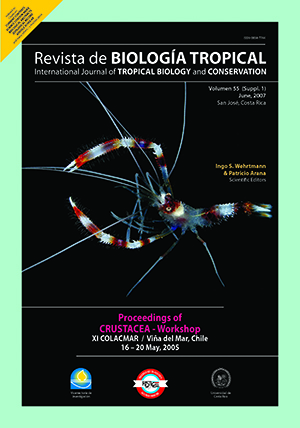Resumen
The life history of ghost shrimps, known for their role in shaping community structures in shallow water habitats, is poorly studied in species occurring along the coasts of the South American Pacific. Here we present ecological information concerning Callichirus seilacheri based upon individuals collected from January to December 2003 in Las Machas beach, northern Chile. Burrow densities varied between 1.4 and 20.2 burrows / 0.25 m2, and was highest during summer (18.2 burrows / 0.25m2). The sex proportion was 1:1 during most of the study period; however, females outnumbered males in January and September. Males reached a larger maximum size than females (27.1 and 24.0 mm CL, respectively). The presence of juveniles was restricted principally to the time between February and May. Sexual maturity was reached at a size of 20.8 mm (males) and 18.1 mm CL (females). The main breeding period lasted from autumn to winter (May to August, peaking in June), and co-occurred with decreasing water temperatures and the presence of a sediment layer covering the burrows.##plugins.facebook.comentarios##

Esta obra está bajo una licencia internacional Creative Commons Atribución 4.0.
Derechos de autor 2007 Revista de Biología Tropical
Descargas
Los datos de descargas todavía no están disponibles.


